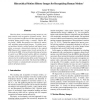Free Online Productivity Tools
i2Speak
i2Symbol
i2OCR
iTex2Img
iWeb2Print
iWeb2Shot
i2Type
iPdf2Split
iPdf2Merge
i2Bopomofo
i2Arabic
i2Style
i2Image
i2PDF
iLatex2Rtf
Sci2ools
109
Voted
EVENT
2001
2001
Hierarchical Motion History Images for Recognizing Human Motion
There has been a recent and increasing interest in computer analysis and recognition of human motion. Previously we presented an efficient real-time approach for representing human motion using a compact "Motion History Image" (MHI). Recognition was achieved by statistically matching moment-based features. To address previous problems related to global analysis and limited recognition, we present a hierarchical extension to the original MHI framework to compute dense (local) motion flow directly from the MHI. A hierarchical partitioning of motions by speed in an MHI pyramid enables efficient calculation of image motions using fixed-size gradient operators. To characterize the resulting motion field, a polar histogram of motion orientations is described. The hierarchical MHI approach remains a computationally inexpensive method for analysis of human motions.
Related Content
| Added | 31 Oct 2010 |
| Updated | 31 Oct 2010 |
| Type | Conference |
| Year | 2001 |
| Where | EVENT |
| Authors | James W. Davis |
Comments (0)

